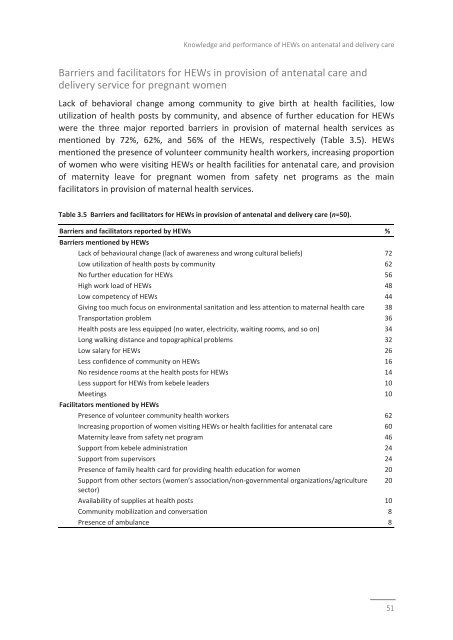araya-thesis
araya-thesis
araya-thesis
Create successful ePaper yourself
Turn your PDF publications into a flip-book with our unique Google optimized e-Paper software.
Knowledge and performance of HEWs on antenatal and delivery care<br />
Barriers and facilitators for HEWs in provision of antenatal care and<br />
delivery service for pregnant women<br />
Lack of behavioral change among community to give birth at health facilities, low<br />
utilization of health posts by community, and absence of further education for HEWs<br />
were the three major reported barriers in provision of maternal health services as<br />
mentioned by 72%, 62%, and 56% of the HEWs, respectively (Table 3.5). HEWs<br />
mentioned the presence of volunteer community health workers, increasing proportion<br />
of women who were visiting HEWs or health facilities for antenatal care, and provision<br />
of maternity leave for pregnant women from safety net programs as the main<br />
facilitators in provision of maternal health services.<br />
Table 3.5 Barriers and facilitators for HEWs in provision of antenatal and delivery care (n=50).<br />
Barriers and facilitators reported by HEWs %<br />
Barriers mentioned by HEWs<br />
Lack of behavioural change (lack of awareness and wrong cultural beliefs) 72<br />
Low utilization of health posts by community 62<br />
No further education for HEWs 56<br />
High work load of HEWs 48<br />
Low competency of HEWs 44<br />
Giving too much focus on environmental sanitation and less attention to maternal health care 38<br />
Transportation problem 36<br />
Health posts are less equipped (no water, electricity, waiting rooms, and so on) 34<br />
Long walking distance and topographical problems 32<br />
Low salary for HEWs 26<br />
Less confidence of community on HEWs 16<br />
No residence rooms at the health posts for HEWs 14<br />
Less support for HEWs from kebele leaders 10<br />
Meetings 10<br />
Facilitators mentioned by HEWs<br />
Presence of volunteer community health workers 62<br />
Increasing proportion of women visiting HEWs or health facilities for antenatal care 60<br />
Maternity leave from safety net program 46<br />
Support from kebele administration 24<br />
Support from supervisors 24<br />
Presence of family health card for providing health education for women 20<br />
Support from other sectors (women’s association/non‐governmental organizations/agriculture 20<br />
sector)<br />
Availability of supplies at health posts 10<br />
Community mobilization and conversation 8<br />
Presence of ambulance 8<br />
51


